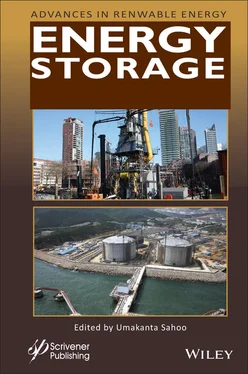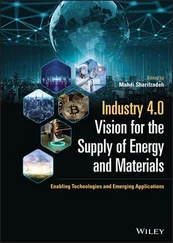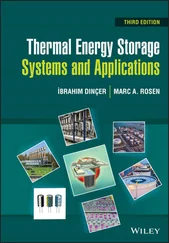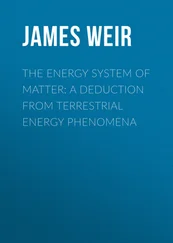1.3.4.1 Sensible Energy Storage
The sensible thermal storage system stores thermal energy with increases in the temperature of the TES material. The principle of the sensible thermal storage system is simple and it has been widely applied in CSP as well as other applications. The TES material undergoes temperature change during energy storage and release. The physical and chemical changes of storage material is not observed. Sensible thermal energy storage method is simple and inexpensive. One of the disadvantages of sensible thermal energy storage material is low thermal conductivity. This results in lesser energy storage and release capacity. Also, the sensible heat transfer materials have low energy storage density. This further leads to large sizes of the storage devices.
The amount of energy stored in the material (Q) can be calculated as

Where m is the mass of the material, C pis the specific heat of the material at constant pressure and Δ T is the temperature difference.
Common sensible storage materials include water, steam, synthetic oil, molten salt, gravel, etc. [see Table 1.4]. As seen from Tables 1.1, 1.2and 1.3, molten salt is widely used for sensible energy storage. Sensible thermal storage systems are mainly seen for low-temperature applications.
Research on sensible thermal storage is comparatively mature and has been developed to a commercially exploitative level. As the density of sensible thermal storage is low, sensible thermal devices typically have certain limitations due to their large sizes. Lucentini (2014) presented thermal storage of sensible heat using concrete modules in solar power plants. Tiskatine et al . (2017) carried out a detailed study on suitability and characteristics of rocks for sensible heat storage in CSP plants. For high-temperature sensible energy storage for CSP systems, the selection and analysis are done by Khare et al . (2013).
Table 1.4 Typical materials used in sensible heat TES storage (Mehling and Cabeza, 2008; Navarro et al ., 2012).
| Material |
Density (kg/m3) |
Specific heat at constant pressure (J/kg K) |
| Clay |
1,458 |
879 |
| Brick |
1,800 |
837 |
| Sandstone |
2,200 |
712 |
| Wood |
700 |
2,390 |
| Concrete |
2,000 |
880 |
| Glass |
2,710 |
837 |
| Aluminium |
2,710 |
896 |
| Iron |
7,900 |
452 |
| Steel |
7,840 |
465 |
| Gravelly earth |
2,050 |
1,840 |
| Magnetite |
5,177 |
752 |
| Water |
988 |
4,182 |
1.3.4.2 Latent Heat Storage
Latent heat storage systems including phase change-based systems have attracted more attention in fundamental research as well as in industrial applications. During latent thermal storage, the storage material is heated until it changes phase at constant temperature conditions. Latent heat energy storage allows efficient storage of thermal energy by minimizing the entropy generation in isothermal processes like evaporation or condensation. Latent heat storage systems employ the enthalpy change of a substance passing through a phase change. In CSP technology the development of absorbers directly generating steam have sparked interest in latent heat storage systems.
Latent energy storage systems have high energy density resulting in easily structured, small and flexible designs. The material that is used for latent heat storage systems is called Phase change material (PCM). Latent heat can be absorbed (charging) as well as can be released (discharging) through phase change of the PCM. The amount of latent heat stored in the material (Q) can be calculated as follows:

Here m is the mass of the material and ∆ h is the enthalpy of phase change.
Even though there are many advantages of latent heat storage system compared to sensible heat storage system, the major disadvantages of PCM are incongruent phase change, high cost, corrosiveness and less thermal stability. As a result, such materials are still in the research stage and it has not been used by industry for CSP-TES applications. There are many materials that can be used as latent heat storage materials and a list with a few important properties is presented in Table 1.5.
Raul et al . (2018) studied modelling and experimental study of latent heat TES with encapsulated Phase change materials for CSP applications. Soares et al . (2013) reviewed passive PCM latent heat TES systems. Agyenim et al . (2010) reviewed materials, heat transfer and phase change issues for latent heat TES systems. Rathod and Barnerjee (2013) carried out a comprehensive study on thermal stability of PCM used in latent heat TES systems. Further, Cárdenas and León (2013) studied design considerations and performance enhancement procedures for high-temperature latent heat TES systems.
Table 1.5 Typical materials used in latent heat TES systems (Mehling and Cabeza, 2008; Navarro et al ., 2012).
| Material |
Melting temperature (ºC) |
Melting enthalpy (MJ/m3) |
| Water-salt solutions |
–100–0 |
200–300 |
| Water |
0 |
330 |
| Clathrates |
–50–0 |
200–300 |
| Paraffins |
–20–100 |
150–250 |
| Salt hydrates |
–20–80 |
200–600 |
| Sugar alcohols |
20–450 |
200–450 |
| Nitrates |
120–300 |
200–700 |
| Hydroxides |
150–400 |
500–700 |
| Chlorides |
350–750 |
550–800 |
| Carbonates |
400–800 |
600–1,000 |
| Fluorides |
700–900 |
> 1,000 |
1.3.4.3 Thermochemical Energy Storage
Although chemical reaction thermal storage has multiple advantages, the chemical reaction process is complex. It sometimes requires catalysers and has certain safety requirements, and there are other difficulties such as a huge one-time investment and low overall efficiency. Thus, it currently remains in the small-scale experimental stage with plenty of problems yet to be solved before any large-scale application.
The theoretical option to store energy at higher densities compared to latent heat or sensible heat storage concepts and the advantage of storing the reactants at ambient temperature make thermochemical storage systems a promising solution for longer term energy storage. On the other hand, thermochemical storage systems show a higher complexity than concepts for sensible heat storage or latent heat storage. The long-term reversibility of the reactions is an important issue. Currently, these systems are at an earlier stage of development, and there have been no commercial applications so far.
1.4 Corrosion Problem in TES-CSP System
The use of TES provides round the electricity generation. However, as seen from the literature, most of the CSP plants use TES involving molten salts at high temperatures. Such materials are highly corrosive which can damage the components of CSP. It is impossible to prevent corrosion in molten salts altogether. The effect of corrosion may be reduced by using protective coating or corrosion resistant material. To use proper and effective coating, the material must have good adhesion properties with the structural material. The coating should be uniform and less porous (Liu et al ., 2014). Another way to supress the effect of corrosion is by application of a cathodic potential (Schwandt and Fray, 2014). Failure due to corrosion is a major issue and such risk of failure of TES system must always be taken into account. Such cost is a function of the costs of HTF and of materials used (Liu et al ., 2016).
Читать дальше














